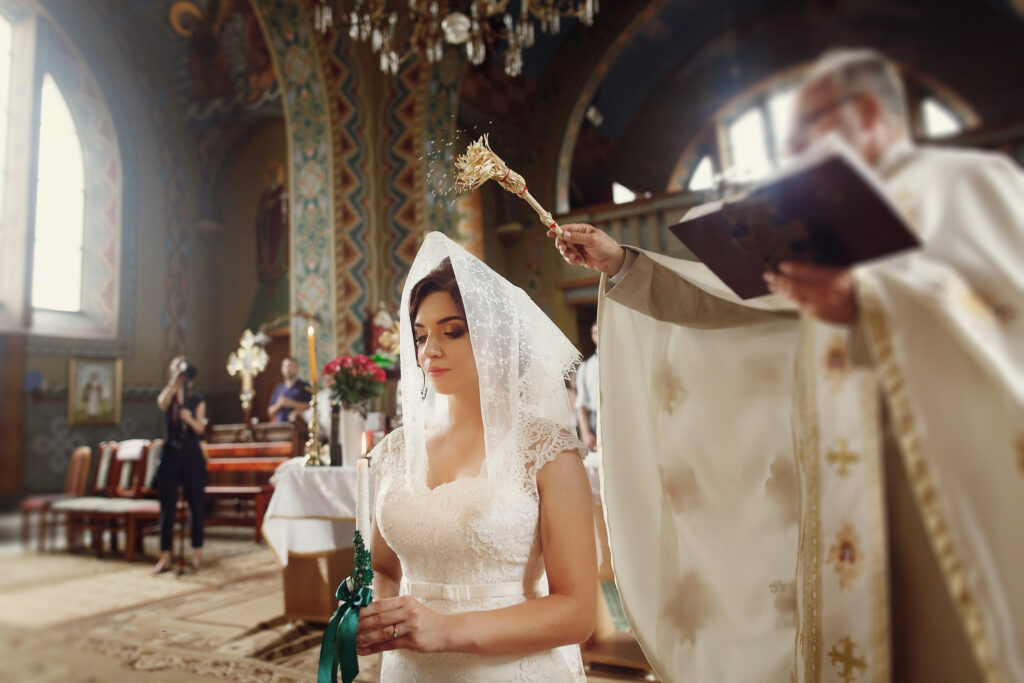Across continents and cultures, Christian weddings are a diverse and breathtaking fusion of faith and local tradition. From the towering cathedrals of Europe to the vibrant communities of Africa, Asia, and the Americas, each celebration brings something utterly unique to the altar. While the sacred promise of unity before God anchors every ceremony, it’s the cultural flourishes–the dances, blessings, and time-honored rituals–that make each one feel like a world of its own.
Easter is the perfect time to take a virtual global tour of some of the most interesting and not-so-known Christian wedding traditions that go beyond the village squares and candlelit chapels and find their roots in families and communities and the faith that has shaped them.

Europe: Where Romance Meets Ritual
Where: Eastern Europe
What: Bread and Salt Ceremony
In Eastern European countries like Russia, Bulgaria, and other Orthodox regions, the newlyweds are greeted with a symbolic offering: a loaf of bread sprinkled with salt. The bride and the groom both take a bite each, representing a willingness to share their new life together in both abundance and adversity. This ritual is rich in flavor and meaning–a first shared act that says, “we can weather anything together.”

Where: Germany
What: Polterabend and Sawing the log
The night before the wedding, friends gather to break porcelain in a raucous celebration called Polterabend, It’s joyful, chaotic, and loud – exactly as it should be! The couple must clean the mess together, setting the tone for teamwork from the outset. On the wedding day, they saw a log in half – a rustic metaphor for partnership, perseverance, and strength in togetherness.
Where: Italy, Greece
What: Confetti and sugared almonds
In Italian weddings, “confetti” isn’t paper – it’s candy-coated almonds tossed in celebration. Each sweet represents fertility, health, and happiness. When they fall, they shimmer like tiny wishes in motion. Greeks echo this with the koufeta packed into elegant bomboniere, a tasteful send-off, and a keepsake of blessings.

Asia: Where Faith Intertwines with Ancient Heritage
Where: Kerala, India
What: Minnu necklace
In Kerala’s Syrian Christian communities, the groom ties a golden pendant called the Minnu around the bride’s neck. It’s a thread of seven strings made out of a Manthrakodi, a red sari. It mirrors Hindu customs in the country but centers the cross – uniting culture and Christ in one exquisite symbol of devotion.
Where: Philippines
What: Veil, Cord, and Coins
A Filipino Christian wedding is less a ceremony and more a tapestry. First, the veil—draped over the bride and groom, symbolizing unity. Then the cord—a figure-eight loop placed over their shoulders to signify eternity. Finally, the arras or “unity coins”–13 coins exchanged as a pledge to provide, protect, and prosper. Each layer is poetic. Each ritual, profoundly tender. It’s a quiet choreography of promise, overseen by godparents and filled with meaning at every turn. The couple’s aspirations for a harmonious life together are symbolized through various cultural rituals, such as the release of white doves in the Philippines.
Where: China
What: Tea Ceremony
Before or after the church vows, many couples in China and neighboring countries kneel to serve tea to their parents and elders. It’s serene. Intentional. Full of reverence. No microphones. No grand gestures. Just the quiet passing of porcelain and blessings across generations. The Tea Ceremony is a significant tradition in Chinese weddings, reflecting respect towards elders and cultural heritage.
The Americas: Tradition with a Twist
Where: Latin America
What: Arras & El Lazo
You might wonder what goes on in Mexican and Central American Catholic weddings. In these regions, the 13 coins (arras) and unity lasso (el lazo) are central in the nuptials between a man and a woman. The coins are offered as a pledge to mutual care, while the lasso–often a giant rosary–is draped over the couple to signify eternal unity. It’s a kind of ceremonial poetry wherein two people are wrapped in grace, one loop at a time.
Where: United States, Evangelical
What: Foot Washing
Inspired by Jesus himself, some couples include a foot-washing ritual during their vows. It’s intimate, humbling, and drenched in meaning. As water is poured and feet are dried, so too is a quiet vow made: to serve, to honor, and to love–daily, deeply, and without ego. Modern couples often adapt traditional wedding customs, such as the Foot Washing ritual, to fit their personal tastes and contemporary lifestyles.
Lorem ipsum dolor sit amet, consectetur adipiscing elit. Ut elit tellus, luctus nec ullamcorper mattis, pulvinar dapibus leo.




